

The pond itinerary
Because the pond and its surroundings are the essence and the heart of the garden, one arrives at it using a series of short, almost secrete trajectories that penetrate a copse of trees and dense shrubbery.
The thickness of the vegetation conceals the objective of the routes from our eyes, but we feel that we are approaching a shell.
The different types of trees, shrubs and herbaceous plants that surround us, as if we were in a tunnel, indicate and anticipate the presence of water.

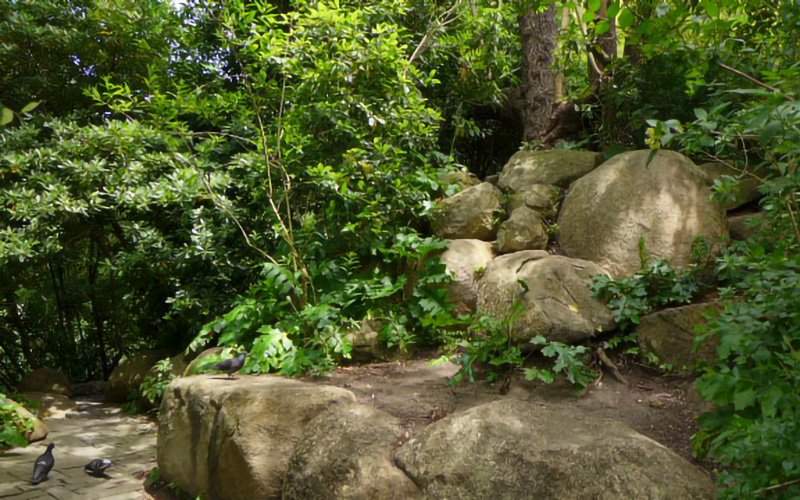
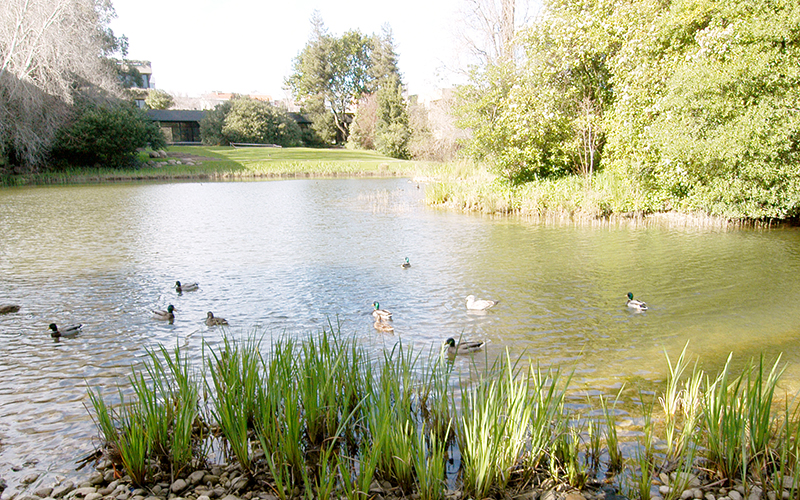
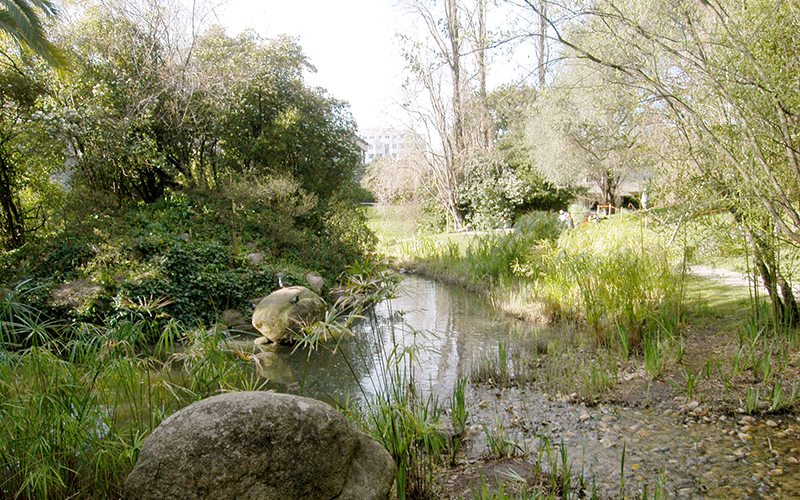

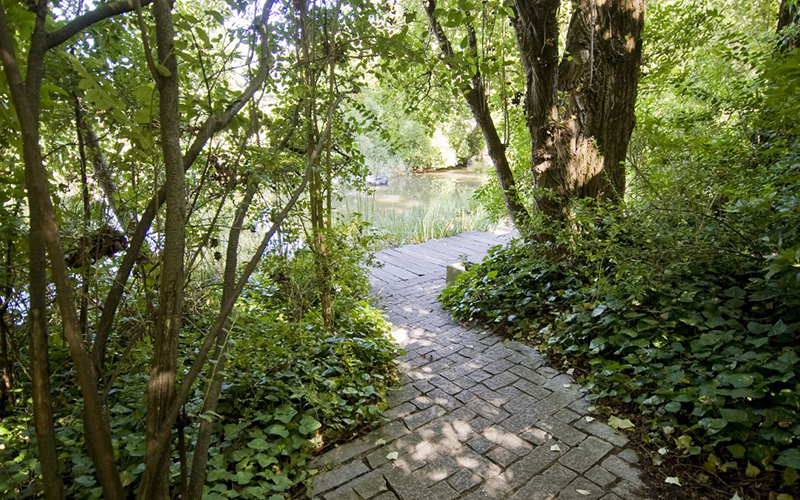
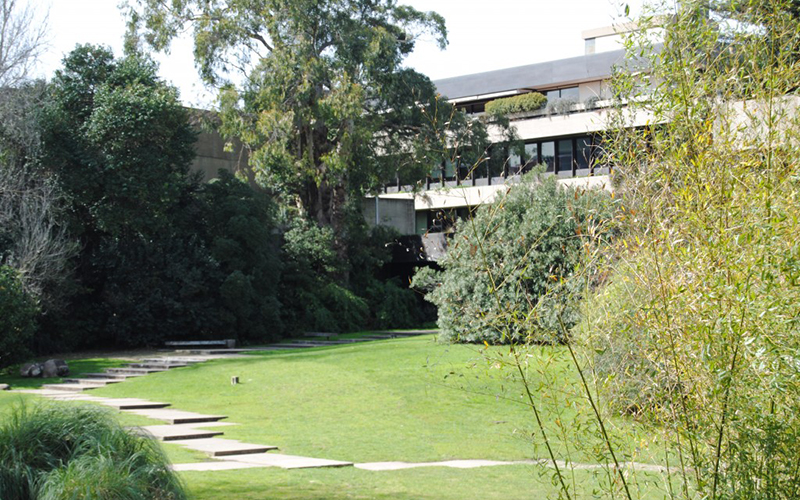

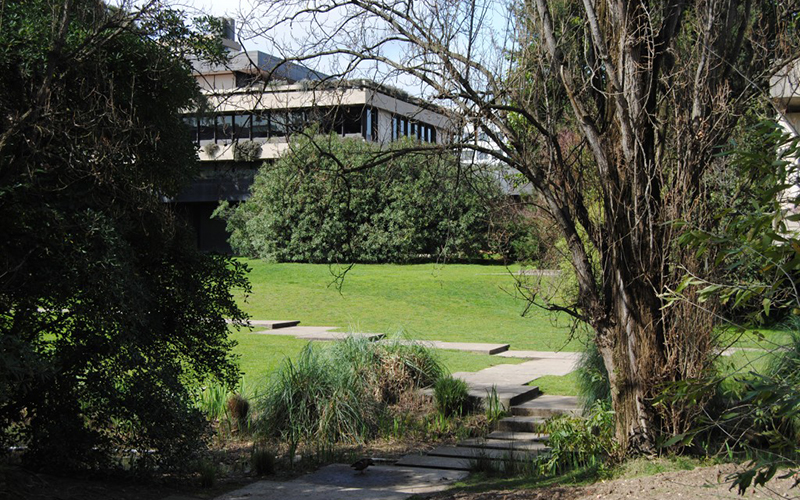

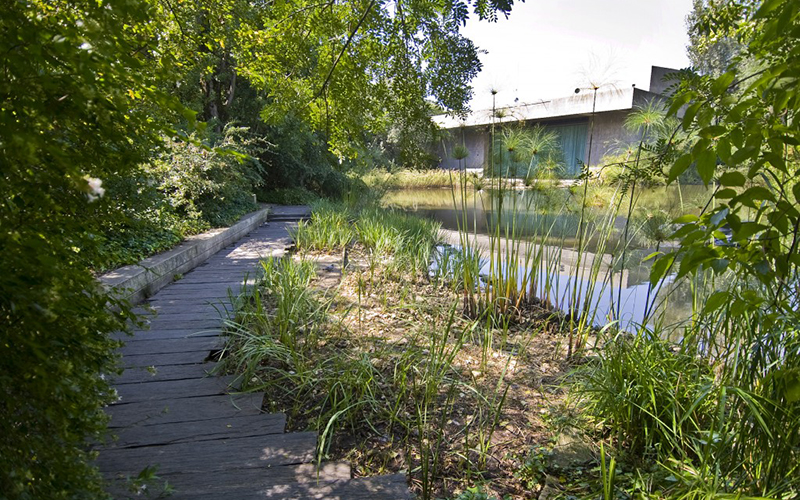
Let us enjoy a little longer these shady, secretive and fragrant retreats, where, now and again, the light is caught by the calm surface of the pond.
The intimacy, isolation and contention determined by the scale of the paths we have been walking and the dimension of the vegetation that embraces them are followed by the amplitude, sociability, color and light that the spacious grassy clearing around the pond offers.
It is here, in this concave shell defined by the slope we have just been exploring and the south facade of the building that a large number of the garden’s visitors choose to gather. Some enjoy observing the garden from the outdoor café next to the building; others rest or play on the grass. We move towards there with the clear feeling that we have reached the essence of the garden, if not what we can call the Time of the Garden. It is in this place — where three streams converge in the interior of the shell designed and constructed between 1963 and 1966 —that the pond offers itself as an enormous mirror reflecting the light, revealing the great discourse of the water. It is here, too, that we feel the furthest away from the hustle and bustle of modern life. The naturalist language with which the pond was built, the vegetation that frames it, the image of heaven on earth that the physicity of the water provides, the game of profundities that all these elements determine and the presence of the island enhances, as well as the ecological diversity and richness that this humid sys-tem guarantees add to this feeling. The city evaporates. Its noise is softened by the sculpted land and vegetation that configure the gar-den. The wind blowing from the north becomes a beneficent breeze thanks to the permeable obstacles it encounters on the way. The gar-den reveals itself in all its plenitude. The idyllic calm that this space instils in us brings to mind the “Island of Love” evoked by Portugal’s greatest poet, Camoes, in Book IX of The Lusíadas: “Where in a smiling vale the mountains end / Form’d in a crystal lake the waters blend / Fring’d was the border with a woodland shade / In ev’ry leaf of various green array’d / Each yellowting’d, each mingling tint between / The dark ash-verdure and the silv’ry green / The trees, now bending forward, slowly shake / Their lofty honors o’er the crystal Lake”.
No matter what route we take to approach the lake, we always have to come through the vegetation that first conceals and protects this place and then reveals it in its full glory. One understands this best when the way to the pond takes one through the dense vegetation to the west or the Amphitheatre. Here one can take in the most well-known panoramic view of the Gulbenkian Garden: the dialogue between the calm surface of the pond and the building, particularly with the huge window in the south facade of the Auditorium. The grandiose volume in inert concrete of the Auditorium advances towards the pond in an almost perfect syntony between inert and living materials — a duality we often consider to be contradictory. The mastery with which this area of the garden was designed and built, in accordance with the ecological principles of a functioning landscape, makes us forget that the scenario we witness is an artificial one. We even forget that part of this landscape is a hanging garden built on the dressing rooms and support areas of the Auditorium.
The pond was studied and designed in meticulous detail, always in close interaction with the buildings, in particular the Auditorium, the Amphitheatre and the Temporary Exhibition Gallery, with which it establishes relations of limits, profundity and complicity. The pond and the covering of the roofs of the car park, the Temporary Exhibition Gallery and the Congress area, which was the result of construction methods that were highly innovative at the time — they were built in concrete with the joints filled with a sub-stance identical to tar that guaranteed the waterproofing, dilatation and contraction of the construction elements — illustrate a high degree of technical knowledge on the part of the landscape architects who designed the garden. The undulated solution on the non-rocky part of the perimeter of the pond was the means found for concretizing the image of a continuous bank that can be found in certain stretches of the pond’s perimeter. The thus defined concavity, when filled with top soil, created the conditions for the planting of water-loving plant species and guaranteed continuity between the pond surface and the adjacent spaces. Along the rest of the pond banks, submersed stone slab walls create a box that allows for plantation. The use of these techniques in both the construction systems conceals the constructed appearance of the banks. This artificial naturalness of the pond is enhanced by the presence of wild birds, which, immediately after conclusion of the work, colonized the garden both as a nesting and a resting place, adding to the garden with their chirping and warbling and their flights that cut the blue of the sky. The daily variations in the level of the pond water, particularly in the summer months when the water is used for watering the garden, also accentuate the naturalistic character of this completely designed and built landscape. The pond we can enjoy today is also a reminder of the garden’s past. Its inspiration was the original pond designed by Jacob Weiss in 1866, but it by no means mimics its predecessor. Which is only natural. In 1961, the design of the pond resulted from the knowledge the designers had of landscape functioning and construction and the relationship between the pond and the whole. The water surface is always the natural continuity of the various surroundings it comes into contact with and is never an overlapping or a rupture, contrary to the design of the pond in 1866, as the maps of the period show. The great eucalyptus tree sheltered in a recess of the building is a legacy from this period and has since been classified as an “outstanding tree”. Its classification refers to its size, age and his-tory but it was only possible because, in 1958, Azevedo Coutinho, wanted it to be saved and because, during the construction work on the Auditorium, the architects, landscape architects, engineers and gardeners protected it and defined the recess of the building. Now let us leave the musing and calm that the heart of the garden with its form, matter and spatiality has created in us. Let us seek out other spaces and ambiences, which, together with the light, shade and water, make up the Calouste Gulbenkian Foundation Garden.